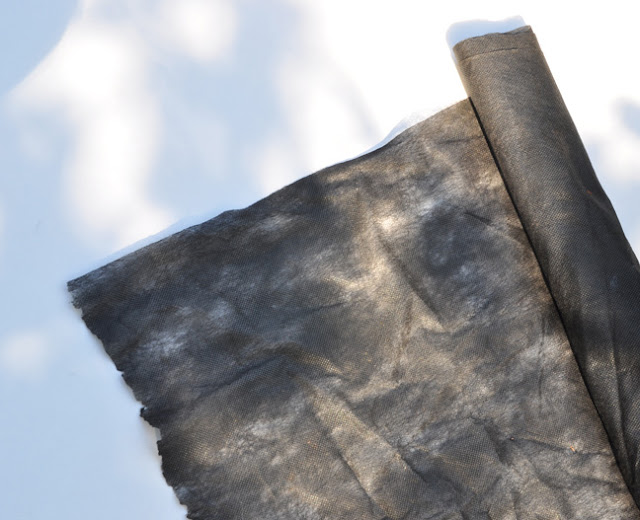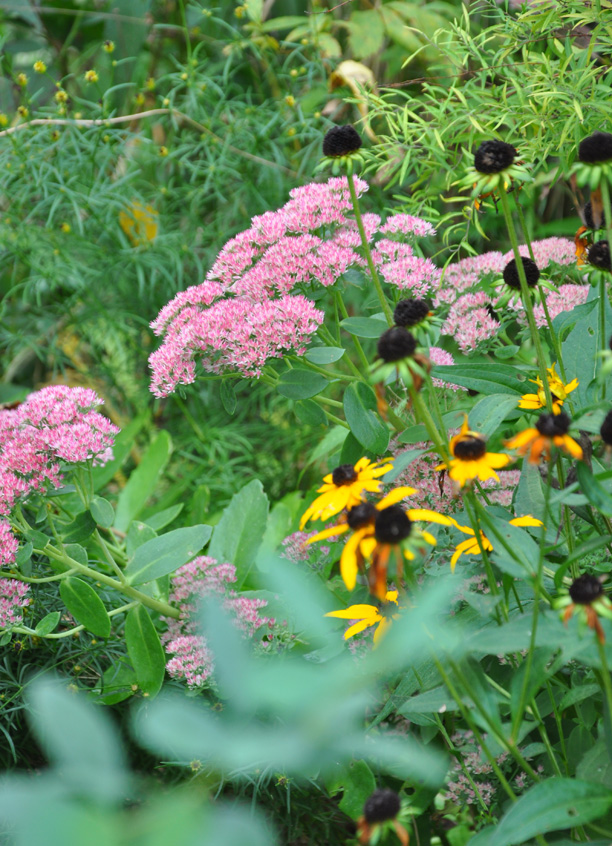Isn't this a gorgeous book cover?
It is just one of the amazing images in the new book Seeing Seed, A journey into the world of Seedheads, Pods & Fruit.
Photographer Robert LLewellyn uses a unique technique known as image stacking to keep every part of his photographs in perfect focus.
Each image begins with a series of photographs that are taken with a variety of focal points. Then all the photographs are merged and blended together with a special computer software program. The results are photographs with breathtaking clarity and detail. (You can see a great example of image stacking in Robert's photograph of a translucent Honesty seedpod, Lunaria annua by clicking the link).
All of the Seeing Seed's photographs are on a crisp white background giving them the look of masterful botanical illustrations.
Meadow Rue seeds in my garden
Allium seeds from my garden
Seeing Seeds is a book you could easily read cover to cover. Certainly author Teri Dunn Chace presents the subject matter in a way that is light and entertaining, as well as informative.
I think however, that this is a book you are more likely to turn to as a reference and end up finding yourself getting lost in its pages.
Before you know it, you'll have expanded your knowledge about the way seeds work without feeling the weight of having learned anything.
Poppy seeds
The book begins with an introductory series of short essays. Seeds vary greatly, yet there are underlying principles and patterns at work. The essays examine the structure and the diversity of forms seeds take, and what seeds do and how they do it. The introduction also examines the way in which seeds fit into the environment as a whole.
Teri Dunn Chace writes,"Everything plants do or can do, every fruit or pod or loose seed, is connected to us and to all living things. There is no autonomy; nothing is entirely solitary. To say we are co-evolutionary with seeds is to gaze at the edge of a mystery. A life force is embedded in everything, not just in seeds." *
* Pg 10. Seeing Seed, A journey into the world of Seedheads, Pods & Fruit by Robert Llewellyn and Teri Dunn Chace, Timber Press, 2015.
They remind us that nature is intricately connected. Plants do not reproduce in isolation; flowers depend on bees and other insects for pollination, on the birds that eat ripe berries and fruit, on animals that carry seed in their fur and on the wind for dispersal.
Milkweed
The second half of the book highlights 100 representative seeds, fruits and pods. Here you will discover interesting stories and a treasure chest of curiosities.
For instance, did you know that Milkweed flowers have a tiny slits in their sides which will often catch the feet of insects that land to drink the nectar?
Saddlebags of pollen held by tiny wire-like filaments will often attach themselves as the insect struggles to free itself. Inevitably some insects fail in their escape attempt and perish on the flower.
To make up for any short fall, Milkweed produces a great abundance of delicate, tan-colored seeds.
Each seed has silky wings that allow them to drift and sail on the wind.
After you read this book, you may find yourself adding plants to your garden for a whole new reason; not for the flowers, but for the ornamental quality of their seeds.
The seeds above may be familiar to you, but have you seen the seeds of Iris domestica or the blackberry lily as it is commonly known? Like daylilies, the small speckled orange flowers of Iris domestica last for a single day. Then the green pods ripen and split to reveal handsome clusters of shiny black seeds that resemble blackberries.
High on my personal list of elegant seeds pods would be that of an old fashioned plant: Lunaria annua. Honesty, Silver Dollars or the Money plant, as it is variously known, forms translucent coin-shaped envelopes to house its seeds. If you tug gently on the small tail at the end of each ripe pod, the protective sides of envelope come away revealing fine brown seeds on a silvery interior shaped like a small coin. (You can see a translucent Silver Dollar here).
For years, my Mom gathered the seeds and used the translucent silver dollars to make dried arrangements she would keep all winter.
Seeds covered with frost in late fall.
I have always thought that seeds have a beauty which rivals that of flowers. This book is sure to convince you of it!
About the Book's Author & Photographer:
Robert Llewellyn has been photographing plants and landscapes for more than forty years. His work has appeared in more than thirty books and includes the books Seeing Flowers and Seeing Trees, which was chosen as one of the best gardening books of the year by The New York Times.
You can see examples of his work on his website: Robertllewellyn.com
Teri Dunn Chace is a writer and editor with more than thirty titles in publication including Seeing Flowers (Timber Press, 2014) and How to Eradicate Invasive Plants (Timber Press, 2013). Chace has gardened in a number of climate zones and with a number of soil types. She now lives in upstate New York. To learn more about the book's author, visit her website: terichacewriter.com
The Book at a Glance:
Book Authors: Robert Llewellyn and Teri Dunn Chace
Publisher: Timber Press
Format: Hardcover
Pages: 284 pp.
Images: 145 color photos
Thomas Allen & Sons has given me a review copy of the new book: Seeing Seed, A journey into the world of Seedheads, Pods & Fruit. I am going to give it away to one lucky reader.
Leave a comment if you would like to be included in the book draw. The draw will remain open for the next 7 days.
If you are not a blogger, you can enter to win on the Three Dogs in a Garden Facebook page.
Please, please make sure there is a way for me to track down your email address should your name be drawn. ( I still have a copy of Grow Gardeners for draw winner Bonnie Johnson because I have been unable to find an email address for her. Bonnie, if you're out there, please email me!)

















































